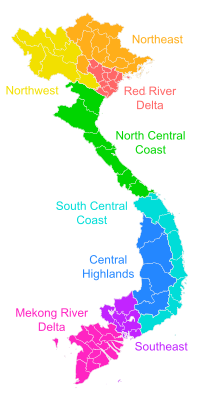Southern Vietnam

Southern Vietnam (
Bình Thuận are sometimes seen as part of the Southeast region, the Southern. Known as Nam Bộ today in Vietnamese, it was historically called as Gia Định
(1779–1832), Nam Kỳ (1832–1945), Nam Bộ (1945–48), and Nam Phần (1948–75).
The origin of Southern Vietnam (Basse-Cochinchine in French, or Lower
Kingdom of Funan (from 1st century CE until 6th century CE) and Khmer Empire (from 8th century CE to 17th century). Southern Vietnam was conquered by the Nguyen force in the 17th and 18th centuries from the Khmer kingdom.[1]
The main ethnicities in Southern Vietnam are
Administration
| Administrative region | First Tier units | Area (km2) | Population (2019)[3] | Population density (people/km2) |
|---|---|---|---|---|
| Southeast (Đông Nam Bộ, Miền Đông) |
Bình Dương Bình Phước Đồng Nai Ho Chi Minh City † Tây Ninh
|
23,590.70 | 19,101,908 | 683.65 |
| Mekong River Delta (Đồng Bằng Sông Cửu Long) or Southwest (Tây Nam Bộ, Miền Tây) |
An Giang Bến Tre Bạc Liêu Cà Mau Cần Thơ † Đồng Tháp Hậu Giang Kiên Giang Long An Sóc Trăng Tiền Giang Trà Vinh Vĩnh Long
|
40,576.00 | 21,015,795 | 434.00 |
^† Municipality (thành phố trực thuộc trung ương)
See also
- Northern, Central and Southern Vietnam
- Six Provinces of Southern Vietnam
- Cochinchina – a historical exonym for South Vietnam
- Champa, ancient coastal states in modern Central and South Vietnam
References
External links
 Southern Vietnam travel guide from Wikivoyage
Southern Vietnam travel guide from Wikivoyage
